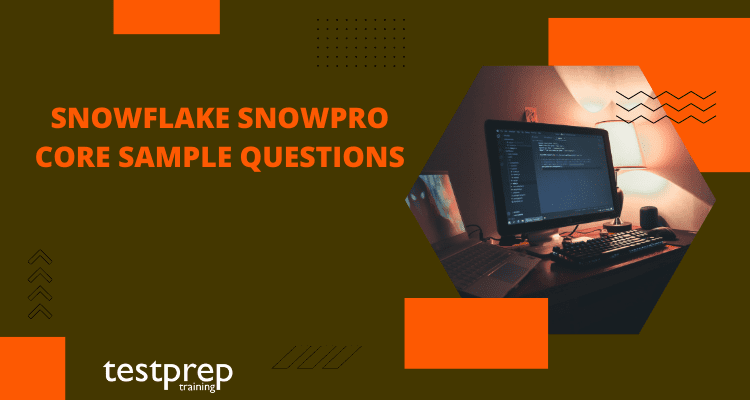Snowflake SnowPro Core Sample Questions

An illustration of how adept a candidate is at utilizing particular core expertise when implementing and migrating to Snowflake is the SnowPro Core Certification test. Candidates for the SnowPro Core Certification will acquire knowledge of Snowflake as a cloud data warehouse. Additionally, they will become more skilled at planning, developing, and managing secure, scalable Snowflake solutions to fulfill business objectives. The following subjects are covered by the Snowflake SnowPro Core Sample Questions:
- Snowflake Overview & Architecture
- Data Movement
- Storage and Protection
- Performance and Tuning
- Snowflake Virtual Warehouses
- Account and Security
- Semi-Structured Data
Advanced Sample Questions
What is the recommended best practice to handle large data sets in Snowflake?
- A. Load the data into a single table
- B. Shard the data into multiple tables
- C. Use a single table with a clustered key
- D. Use a single table with a non-clustered key
Answer: B. Shard the data into multiple tables
Explanation: Snowflake is designed for handling large amounts of data and sharding the data into multiple tables can help to improve the performance and scalability of the data. By dividing the data into smaller, more manageable chunks, queries can be executed more quickly and efficiently.
What is the purpose of a virtual warehouse in Snowflake?
- A. To store data
- B. To manage the resources used for data processing
- C. To secure data access
- D. To monitor data usage
Answer: B. To manage the resources used for data processing
Explanation: A virtual warehouse in Snowflake is used to manage the resources used for data processing, such as CPU, memory, and storage. By creating a virtual warehouse, you can control the resources used by Snowflake and allocate the appropriate resources for your specific workloads.
How can you secure data in Snowflake?
- A. Use Snowflake security policies
- B. Use network security groups
- C. Use Snowflake encryption
- D. All of the above
Answer: D. All of the above
Explanation: Snowflake provides multiple security features to help secure your data, including security policies, network security groups, and encryption. By using these features, you can ensure that your data is protected and only accessible by authorized users.
How can you improve the performance of a query in Snowflake?
- A. Use an appropriate data type for columns
- B. Use the appropriate sort order for columns
- C. Use a clustered key
- D. All of the above
Answer: D. All of the above
Explanation: Snowflake provides several features to help improve the performance of queries, including using an appropriate data type for columns, using the appropriate sort order for columns, and using a clustered key. By using these features, you can ensure that your queries are executed quickly and efficiently.
What is the purpose of a materialized view in Snowflake?
- A. To store data
- B. To improve query performance
- C. To secure data access
- D. To monitor data usage
Answer: B. To improve query performance
Explanation: A materialized view in Snowflake is a precomputed, summarized version of a query that can be used to improve query performance. By using a materialized view, you can reduce the amount of data that needs to be scanned and processed, which can help to improve the performance of your queries.
What is the purpose of a Snowflake stage?
- A. To store data temporarily
- B. To secure data access
- C. To manage the resources used for data processing
- D. To monitor data usage
Answer: A. To store data temporarily
Explanation: A Snowflake stage is a location within Snowflake where data can be temporarily stored during the loading or unloading process. Stages can be used to store data during the transfer of data between Snowflake and external storage, or to store data during the processing of data within Snowflake.
What is the recommended best practice for loading data into Snowflake?
- A. Load data directly into a table
- B. Load data into a stage first, then into a table
- C. Load data using a single query
- D. Load data using multiple queries
Answer: B. Load data into a stage first, then into a table
Explanation: The recommended best practice for loading data into Snowflake is to first load the data into a stage, then use a COPY INTO command to load the data into a table. This helps to ensure that the data is loaded into Snowflake efficiently and can also help to improve the performance of subsequent queries against the data.
How can you improve the security of data in Snowflake?
- A. Use Snowflake security policies
- B. Use network security groups
- C. Use Snowflake encryption
- D. All of the above
Answer: D. All of the above
Explanation: Snowflake provides multiple security features to help improve the security of data, including security policies, network security groups, and encryption. By using these features, you can ensure that your data is protected and only accessible by authorized users.
What is the purpose of a Snowflake role?
- A. To store data temporarily
- B. To secure data access
- C. To manage the resources used for data processing
- D. To monitor data usage
Answer: B. To secure data access
Explanation: A Snowflake role is used to secure data access in Snowflake by defining the privileges that users have to access specific objects within Snowflake, such as tables and views. By using roles, you can ensure that only authorized users have access to specific data.
How can you improve the performance of a query in Snowflake?
- A. Use an appropriate data type for columns
- B. Use the appropriate sort order for columns
- C. Use appropriate data compression
- D. All of the above
Answer: D. All of the above
Explanation: Snowflake provides several features to help improve the performance of queries, including using an appropriate data type for columns, using the appropriate sort order for columns, and using appropriate data compression. By using these features, you can ensure that your queries are executed quickly and efficiently, and that your data is stored in an optimal format for query performance.
Basic Sample Questions
Q1)Customers have the option to alter Snowflake’s built-in clustering methods. This approach is:
- A. Micro-partitions
- B. Clustering keys
- C. Key partitions
- D. Clustered partitions
Correct Answer: B
Q2)What Scaling Policies for the Snowflake Virtual Warehouse are legitimate? (Select two.)
- A. Custom
- B. Economy
- C. Optimized
- D. Standard
Correct Answer: B and D
Q3)True or false: Multiple Snowflake accounts can contain the same database.
- A. True
- B. False
Correct Answer: B
Q4)Which role from the list above should be used to create and manage users and roles?
- A. SYSADMIN
- B. SECURITYADMIN
- C. PUBLIC
- D. ACCOUNTADMIN
Correct Answer: D
Q5)True or False: Snowflake enables the usage of a SELECT statement for loading data in bulk.
- A. True
- B. False
Correct Answer: A
Q6)Choose from the several Internal Stages: (Select three.)
- A. Named Stage
- B. User Stage
- C. Table Stage
- D. Schema Stage
Correct Answer: A,B and C
Q7)You can keep track of account-level storage consumption by using:
- A. The Snowflake Web Interface (UI) in the Databases section
- B. The Snowflake Web Interface (UI) in the Account -> Billing & Usage section
- C. The Information Schema -> ACCOUNT_USAGE_HISTORY View
- D. The Account Usage Schema -> ACCOUNT_USAGE_METRICS View
Correct Answer: B
Q8)Based on: Credit Consumption by the Compute Layer (Virtual Warehouses): (Choose two.)
- A. Number of users
- B. Warehouse size
- C. Amount of data processed
- D. # of clusters for the Warehouse
Correct Answer: B and C
Q9)Which of the following best sums up “clustering”?
- A. Clustering describes how Snowflake’s micro-partitions’ data is organized and stored.
- B. For each Snowflake table, the database administrator must specify the clustering algorithm.
- C. When loading data into Snowflake, the COPY command must include the clustering key.
- D. In a Snowflake account, clustering can be turned off.
Correct Answer: A
Q10)The Virtual Warehouse is configured for a session by which of the following commands?
- A. COPY WAREHOUSE FROM <<config file>>;
- B. SET WAREHOUSE = <<warehouse name>>;
- C. USE WAREHOUSE <<warehouse name>>;
- D. USE VIRTUAL_WAREHOUSE <<warehouse name>>;
Correct Answer: C
Q11)Which of the following items is capable of being copied? (Select four.)
- A. Tables
- B. Named File Formats
- C. Schemas
- D. Shares
- E. Databases
- F. Users
Correct Answer: A,C,E and F
Q12)Which object enables you to set a credit consumption cap for a Snowflake account?
- A. Account Usage Tracking
- B. Resource Monitor
- C. Warehouse Limit Parameter
- D. Credit Consumption Tracker
Correct Answer: B
Q13)What kinds of workloads are Snowflake’s specifications? (Select two.)
- A. OLAP (Analytics) workloads
- B. OLTP (Transactional) workloads
- C. Concurrent workloads
- D. On-premise workloads
Correct Answer: A and B
Q14)What kinds of workloads are Snowflake’s specifications? (Select two.)
- A. Compute
- B. Tri-Secret Secure
- C. Storage
- D. Cloud Services
Correct Answer: A,C and D
Q15)Why would a client change the size of a virtual warehouse from X-Small to Medium?
- A. To support additional queries
- B. To support additional users
- C. To account for shifts in workload
- D. In order to handle a more complicated workload
Correct Answer: A
Q16)True or False: Since Reader Accounts just read shared data without making any changes, there are no additional compute costs for the Data Provider.
- A. True
- B. False
Correct Answer: B
Q17)Which of the following connections supports MFA authorization during connection? (Select each that applies.)
- A. JDBC
- B. SnowSQL
- C. Snowflake Web Interface (UI)
- D. ODBC
- E. Python
Correct Answer: A,B,C,D and E
Q18)Which of the following best sums up the advantages of Snowflake’s compute and storage separation? (Select each that applies.)
- A. Storage and compute growth are closely related to one other
- B. Storage can grow without requiring extra computing
- C. Without the need to add more storage, compute can be scaled up or down.
- D. Data stored on many compute clusters can be accessed without conflict
Correct Answer: B,C and D
Q19)Which architectural tier does Snowflake’s metadata statistics storage reside in?
- A. Storage Layer
- B. Compute Layer
- C. Database Layer
- D. Cloud Services Layer
Correct Answer: D
Q20)Which of the following claims about virtual warehouses is accurate? (Select each that applies.)
- A. warehouse’s size can be changed by customers after it is created.
- B. warehouses can be resized while they are running.
- C. warehouses can be set to suspend after a certain amount of inactivity.
- D. When new queries are sent, A Warehouse can be programmed to automatically resume.
Correct Answer: B and C


